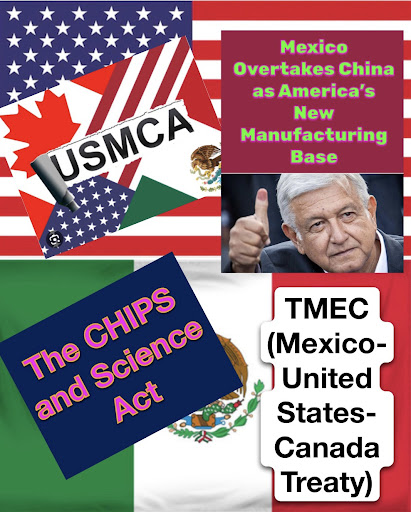In the Spotlight
Nick R. Hamilton
August 20, 2023
From Slay News

As U.S. relations with China have fractured over the years, Mexico has emerged as the new manufacturing base for America.
Doing business overseas has become increasingly more expensive.
Due to the rising costs, experts believe that Mexico has now overtaken China to become the top manufacturer for American companies.
At the beginning of 2023, Mexico became the top U.S. trading partner with bilateral trade between the two countries totaling $263 billion during the first four months of this year, according to a report from the Federal Reserve Bank of Dallas.
“Mexico’s emergence followed fractious U.S. relations with China, which had moved past Canada to claim the top trading spot in 2014,” said the Federal Reserve Bank of Dallas.
“The dynamic changed in 2018 when the U.S. imposed tariffs on China’s goods and with subsequent pandemic-era supply-chain disruptions that altered international trade and investment flows worldwide.
“Mexico’s gains mirror its rise in manufacturing, a key component of goods moving between it and the U.S. During the first four months of 2023, total trade of manufactured goods between Mexico and the U.S. reached $234.2 billion.”
The report from the Federal Reserve Bank of Dallas goes on to state that Mexican imports to the United States totaled $157 billion; U.S. exports to Mexico reached $107 billion. Mexico–U.S. trade during the first four months of 2023 represented 15.4 percent of all the goods exported and imported by the United States; the Canada–U.S. share followed at 15.2 percent and then the China–U.S. share at 12.0 percent.
In 2022 the Mexican government made a bold announcement that several hundred companies had shown interest in relocating to Mexico after the pandemic revealed the vulnerabilities of the present global supply chain, which was dominated by China.
“The health crisis caused by COVID-19, the war between Russia and Ukraine, and the slowdown of the economy in China have affected the global chains of production and distribution of raw materials and this has generated a negative impact on the global market,” said the Secretary of the Economy of Mexico Raquel Buenrostro.
“The challenges caused by these world events have motivated the need to strengthen regional markets and supply chains in key economic sectors for our country.
“The Government of Mexico was able to face the crisis caused by the pandemic.”
Ms. Buenrostro went on to state that because of Mexico’s ability to “weather the storm,” it has attracted the attention of several North American companies to relocate south of the border.
“Currently there is the intention of more than 400 North American companies to carry out a relocation process from Asia to Mexico.
“This is a sign of the importance of the TMEC (Mexico-United States-Canada Treaty), a trade agreement where ties with the United States and Canada have been strengthened, and where an institutional framework was established that grants legal certainty to investors, businessmen, and consumers in the region.”
“American and International companies (including Mexican companies) are setting up and have been setting up now for the past five to seven years production in Mexico because it’s close to the market,” Ricardo Rubiano, founder of real estate investment firm RubiGroup Capital, told The Epoch Times.
“The products are delivered quickly into the United States marketplace.
“We have a cultural relationship with Mexico that we understand better, 30% of the population in the United States will be Hispanic.
“So there is a lot of interconnectivity with a country like Mexico.”
The phenomenon of companies moving their manufacturing bases to Mexico and closer to the U.S. market is part of a trend known as “nearshoring.”
Where a company cuts shipping costs by doing business in a nearby country instead of overseas.
“If companies manufacture in Mexico there’s no shipping overseas, there’s no oceans to cross,” said Rubiano, whose company operates along the U.S.-Mexico border.
“You can have something manufactured and shipped into the northeast in just a few days rather than however long it takes to cross the Panama Canal in order to get it into Houston or the East Coast.”
It’s a transformation for Mexico that could eventually lead it to replace China as the world’s factory, according to experts.
“Mexico is indeed experiencing what some call a new ‘Mexican moment’ with increased nearshoring and reshoring investments as U.S. firms look to diversify and shorten their supply chains,” said Andrew Rudman, director of the Wilson Center’s Mexico Institute.
“COVID-19 demonstrated the risks of dependence on long supply chains based on a single supplier or location.
“In addition, the USMCA (United States-Mexico-Canada Agreement) has created a strong, predictable platform from which to manufacture for the U.S. market. Mexico has seen substantial flows of investment, including from China, into warehousing and assembly operations, particularly in northern Mexico.
“Investment in new factories is also occurring at this time, from Asia, Europe, and from the United States.”
Mexico is even looking to capitalize on the race to develop semiconductors that power mobile phones, cameras, microphones, and other electronic equipment by luring more tech businesses to the country.
According to the Semiconductor Industry Association, 80 percent of the world’s semiconductors (pdf) are produced in Asia.
But due to the rise of geopolitical tensions and supply chain disruptions, the reliance on Asia to produce the hundreds of parts needed to create a mobile device has left the United States in a vulnerable position.
In an attempt to achieve chip sovereignty, the United States has unleashed 52 billion dollars in order to create a domestic supply chain for smart products through the Chips and Science Act.
“The CHIPS and Science Act provides $52.7 billion for American semiconductor research, development, manufacturing, and workforce development,” the White House said in a press release.
“This includes $39 billion in manufacturing incentives, including $2 billion for the legacy chips used in automobiles and defense systems, $13.2 billion in R&D and workforce development, and $500 million to provide for international information communications technology security and semiconductor supply chain activities.”
Though making all those parts on U.S. soil would be a tall order which is why a strategic partnership with Mexico to manufacture chips could be to the benefit of both countries.
Mexico has been building a new “silicon valley” from where it hopes to build chips in a corridor from Mexico City to the cities along the U.S. border.
“When you look at the industrial expansion in that corridor, Tesla is under construction in Monterrey, along with Sony and Samsung,” Rubiano said.
“Almost any Fortune 500 entity is now operating in Mexico or expanding their presence in Mexico significantly.”




